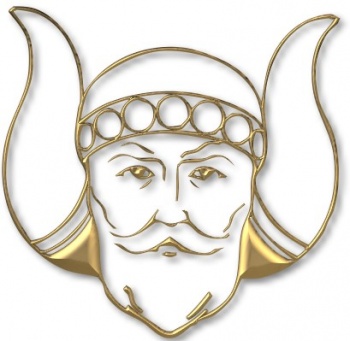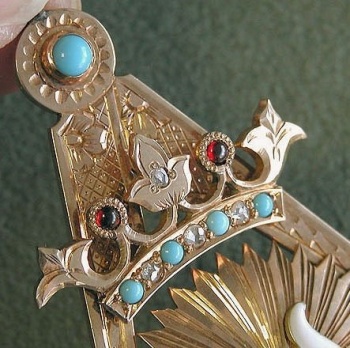Grotto: Unterschied zwischen den Versionen
K (Formatiert) |
K (Formatiert) |
||
| Zeile 1: | Zeile 1: | ||
| − | |||
[[Datei:12945 234559192278 191452707278 4614598 6628136 n.jpg|thumb|350px|Quelle: [[Phoenixmasonry]]]] | [[Datei:12945 234559192278 191452707278 4614598 6628136 n.jpg|thumb|350px|Quelle: [[Phoenixmasonry]]]] | ||
| Zeile 8: | Zeile 7: | ||
[[Datei:12945 234559207278 191452707278 4614600 3731591 n.jpg|thumb|350px]] | [[Datei:12945 234559207278 191452707278 4614600 3731591 n.jpg|thumb|350px]] | ||
| + | |||
| + | == Grotto == | ||
| + | |||
| + | Geselligkeitsorganisation | ||
== Propheten, Verschleierte == | == Propheten, Verschleierte == | ||
| − | Quelle: [[Lennhoff, Posner, Binder]] | + | '''Quelle: [[Lennhoff, Posner, Binder]]''' |
| + | |||
Mystic Order of Veiled Prophets of the Enchanted Realm, amerikanische Geselligkeitsorganisation mit Ritual ähnlich den [[Shriners]] (s.d.), nur Freimaurern zugänglich, die den Meistergrad besitzen. Jede lokale Unterabteilung heißt "Grotto". Die Mitglieder tragen Turbane mit silberdurchwirktem Schleier. Jedes Grotto hat seine eigene Farbe. Die Mitglieder des "Obersten Rates" sind an Purpurturbanen kenntlich. | Mystic Order of Veiled Prophets of the Enchanted Realm, amerikanische Geselligkeitsorganisation mit Ritual ähnlich den [[Shriners]] (s.d.), nur Freimaurern zugänglich, die den Meistergrad besitzen. Jede lokale Unterabteilung heißt "Grotto". Die Mitglieder tragen Turbane mit silberdurchwirktem Schleier. Jedes Grotto hat seine eigene Farbe. Die Mitglieder des "Obersten Rates" sind an Purpurturbanen kenntlich. | ||
| Zeile 17: | Zeile 21: | ||
== Grotto bei Mackey== | == Grotto bei Mackey== | ||
| − | Quelle: Mackey's Encyclopedia of Freemasonry frei übersetzt von H. Thorandt | + | '''Quelle: Mackey's Encyclopedia of Freemasonry, frei übersetzt von H. Thorandt''' |
| + | |||
Der vollständige Name dieser Organisation ist "Mystischer Orden der verschleierten Propheten des begeisterten Reichs". | Der vollständige Name dieser Organisation ist "Mystischer Orden der verschleierten Propheten des begeisterten Reichs". | ||
Aktuelle Version vom 6. Oktober 2018, 11:23 Uhr

Inhaltsverzeichnis
Grotto
Geselligkeitsorganisation
Propheten, Verschleierte
Quelle: Lennhoff, Posner, Binder
Mystic Order of Veiled Prophets of the Enchanted Realm, amerikanische Geselligkeitsorganisation mit Ritual ähnlich den Shriners (s.d.), nur Freimaurern zugänglich, die den Meistergrad besitzen. Jede lokale Unterabteilung heißt "Grotto". Die Mitglieder tragen Turbane mit silberdurchwirktem Schleier. Jedes Grotto hat seine eigene Farbe. Die Mitglieder des "Obersten Rates" sind an Purpurturbanen kenntlich.
Grotto bei Mackey
Quelle: Mackey's Encyclopedia of Freemasonry, frei übersetzt von H. Thorandt
Der vollständige Name dieser Organisation ist "Mystischer Orden der verschleierten Propheten des begeisterten Reichs".
Al Mokanna
Al Mokanna, der verschleierte Prophet, dies ist eine Verkürzung des Namens Hakem ben Haschem, der nach Persischen Aufzeichungen etwa zwischen dem siebenten und achten Jahrhungdert lebte. Einige Autoritäten gaben auch den Namen des Propheten, Al Mokanna der Verschleierte als Al Hakim ibn Otto an, und datierten seine Aktivitäten um das Jahr 760. Er hieß deshalb der Verschleierte, weil er seine Prophezeiungen hinter einem Schleier geäußert hat.
History of the Grotto
BITTE ÜBERSETZEN
The Mystic Order of Veiled Prophets of the Enchanted Realm, whose subordinate bodies are the Grottoes, is an organization by and for Master Masons. While in no way connected with Masonry proper, its membership is restricted absolutely and exclusively to Master Masons in good standing. Although it is primarily an organization for good wholesome fun and frolic, it also has its serious side. Its slogan is "Good Fellowship", and in contact with our fellowman, this principle is exemplified to a marked degree.
For some years prior to 1889, several members of Hamilton Lodge N0. 120, F.& A.M., at Hamilton, New York, sought relaxation from the sterner duties of life by holding occasional informal meetings for fun and good fellowship. The chief spirit in the fun was LeRoy Fairchild, and in the summer of 1889, he and a devoted band of followers discovered the Enchanted Realm in which, upon entering with song and laughter, they and their successors have found a rich heritage. The first meeting of this organization was held on the 10th day of September, 1889. It was decided at this meeting that the membership of the organization should be confined to Master Masons in good standing.
The idea of the Order proved immediately attractive. Many distinguished Masons entered the Enchanted Realm and returned pleased and charmed by its brilliancy. The Order could no longer be confined to one locality and in response to imperative requests that were not to be denied, on the 13th of June, 1890, the "F.D.C." duly founded and established the Supreme Council of the Mystic Order of Veiled Prophets of the Enchanted Realm.
It is a social organization for the Master Mason and all such are welcome to our Enchanted Realm. It encourages renewed interest in the Blue Lodge, its activities and attendance. While it is not and makes no claim to be a part of Symbolic Craft Masonry, they ever bear in mind that their membership is composed entirely of Master Masons.
The ritual is original and unique. The spectacular ceremonial requires a cast of thirty (30) or more and offers unlimited opportunities in stage activities and stunt performance. Its proper rendition requires a large stage, elaborate costumes, and stage settings. It is mysterious, startling and spectacular with a Persian atmosphere. While pervaded with a spirit of wholesome fun, it teaches a serious lesson which lingers with the initiate, instilling in him a spirit of optimism, a kindly feeling for his brother man, and an impression of GOOD FELLOWSHIP, which is something devoutly to be desired.
That the Grotto occupies a legitimate place and is doing a wonderful work cannot be denied. It extends the hand of Good Fellowship to all Master Masons, having a smile for all and a frown for none.
In June 1949, at its Supreme Council Session, the delegates adopted a resolution to establish a national charitable program, which was to be named the Humanitarian Foundation. In 1951, their first project was "Aid for the Cerebral Palsy Child". In 1953 they adopted the Enchanted Lantern to represent contributions made. For each $50 tax-deductible donation, a certificate, receipt and emblem are issued. From 1953 to 1970 the main thrust of the charitable trust was the Cerebral Palsy child.
In 1969 the Humanitarian Foundation Trustees expanded their scope, by adopting the Dental Care for Children with Special Needs. They met and agreed the Grotto would establish a dental clinic for the children with special needs at the Illinois Masonic Medical Center. In 1987, the Medical College of Ohio in Toledo, Ohio and in 2000 the Children's Medical Center in Dallas, Texas became National Treatment Centers.
Today the Humanitarian Foundation, not only remembers the "forgotten child" (child with cerebral palsy) with the annual contribution to research, but combines a unique partnership with qualified dentists throughout the United States and Canada. The program is designed to help these children with special needs, under the age of 18, receive the best dental care possible.
Links
- Nordamerikanische Grottos http://www.scgrotto.com/
- Masonic Dictionary über Grotto http://www.masonicdictionary.com/grotto.html
- Wikipedia https://en.wikipedia.org/wiki/Mystic_Order_of_Veiled_Prophets_of_the_Enchanted_Realm



